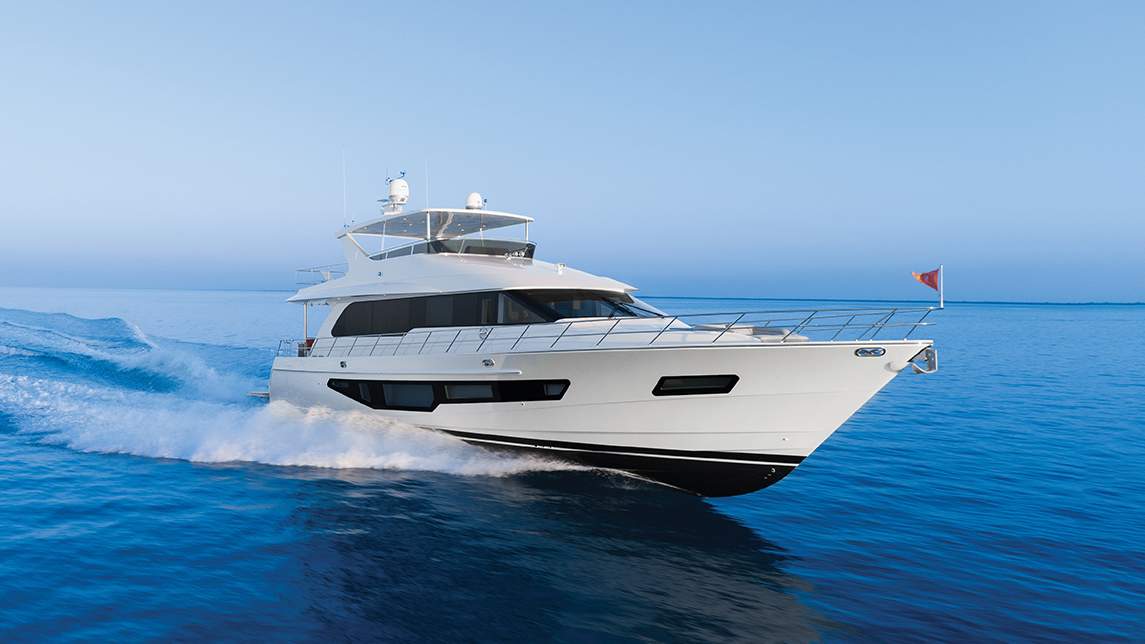
The CLB72 launches a new design direction for the nearly 150-year-old builder.
I had an appointment to meet with Cheoy Lee Shipyards Director Martin Lo and his nephew, Project Manager Hans Lo at their 2018 Ft. Lauderdale International Boat Show display, but I almost walked right past it. Then I stopped and did a double-take. The booth was decked out with bright orange flags bearing the unfamiliar logo of “CL Yachts”, and at the dock behind them sat two motoryachts with ultra-sleek lines and a vast array of windows above and below the waterline. This is not what I had expected from Cheoy Lee at all.
Let me hasten to add that I respect Cheoy Lee, a Hong Kong shipyard that dates back to 1870. Over the course of my career, I have sea-trialed several of its yachts and found them to be sound, seaworthy vessels. But this ultra-chic, contemporary look was something new.
“CL Yachts is a new page, a new luxury performance division of Cheoy Lee,” Martin Lo said. “We are at a turning point of introducing new design philosophies; a new direction as to how we approach the yacht market. We shall put our focus on design, performance, luxury, more catered for the current market—the younger generation.”
While Cheoy Lee Shipyards continues to build custom yachts, CL Yachts’ focus is on production motoryachts. They will be marketed globally, but Hans Lo said the first CL Yachts models are targeted primarily at American buyers, who represent the largest segment of its market.
“The majority of the components are purchased in the U.S., so parts are readily available [here],” he said. Cheoy Lee also maintains a yacht service and maintenance operation in Ft. Lauderdale. There are two CL Yachts lines: the A and B Series. As the nomenclature suggests, they are based on Cheoy Lee’s earlier Alpha and Bravo Series models; high-performance cruisers and family-oriented cruisers, respectively. The two CL Yachts on display at the boat show were the CLA76, a redesigned version of the Cheoy Lee Alpha 76 Flybridge, and the CLB72, an evolution of the Cheoy Lee Bravo 72.
Both models have received major updates in keeping with the company’s new design direction. On the CLA76, “The pilothouse has been elongated to create more living area,” Martin said, adding, “it used to have three staterooms, but now it has four. I believe the market is looking for four staterooms.”
The CLB72 has undergone an even more radical transformation. “We created expanded windows to bring the outside in,” said Hans.
In order to accomplish this, the builder asked naval architect Howard Apollonio, who designed the Bravo 72’s original hull, to come back to the drafting table. The shipyard also hired composites engineering specialist firm Gurit to carry out an extensive finite element analysis in order to ensure that adding glazing to the hull sides would not negatively affect the yacht’s structural integrity or impact its RINA certification.
As a result, each of the CLB72’s four staterooms has a larger window area, providing a better connection for owners and guests with the sea. What’s more, in the master stateroom, the dual sinks and vanity—originally located along a side wall and partially obstructing the view—were moved aft. There, along with a walk-in closet, they provide more separation and privacy between the master stateroom and the crew’s quarters, just aft. The stunning new “feature” wall that the CL Yachts design team placed between the master stateroom and head incorporates contemporary glass doors and windows that turn from clear to opaque at the flip of a switch.
On the main deck, the CLB72’s salon and galley windows now have fewer mullions than on the original yacht, and the windshield has two large panes instead of four. The additional light that this new glazing brings into the interior, along with a more open layout, light gray flooring and white oak cabinetry, creates an airy, contemporary “beach house” ambiance throughout the interior. Stitched leather inset panels on the loose, apartment-style furniture and wall coverings add a touch of luxury. Advanced technology also is present in the form of the matte black Fenix NTM nanotech material covering the galley countertops. If you accidentally should mar this material, Martin said, “You can put a wet cloth on it and iron the surface. It will heal itself.”
In keeping with a family-centric yacht design, the CLB72’s exterior decks are spacious and accommodating. There is a huge double sunpad on the bow, and the flybridge has a large, L-shaped settee for dining and entertaining, served by a bar and outdoor barbecue. The main aft deck offers another alfresco dining area and additional wet bar. But, on sunny days, the focal point on this boat will undoubtedly be the swim platform and extended transom lift that acts as a beach club once the tender is deployed.
CL Yachts also enhanced the CLB72’s performance with a propulsion upgrade to twin 1,000-hp Volvo Penta IPS1350s matched to the Volvo Active Interceptor automatic trim system; both are standard equipment.
“Volvo was very pleased with the engine room [layout],” said Panu Virtanen, CL Yachts vice president for yacht sales, new construction and brokerage, who joined us for a sea trial of the CLB72 off Ft. Lauderdale shortly after the show. The larger IPS engines are a perfect fit in the engine room, although it originally was designed to accommodate 800-hp IPS engines, and there is good access to all service ports.
“We spent a lot of time on the layout of the engine room,” said Martin. “A happy captain equals a happy owner.”
Volvo Penta prides itself in supplying yacht propulsion solutions “from top to prop,” and the new CLB72 showcases many of them. It has two Volvo Penta joystick wing stations on the aft deck, which the CL Yachts’ captain used to maneuver the boat effortlessly out of a very tight space on the dock at Pier Sixty-Six Marina. The IPS pod drives system, which gives you nearly 360-degree maneuverability at low speeds, makes installing a bow and stern thruster unnecessary. “You eliminate those service points,” Virtanen said.
The CLB72 has both an upper and lower helm station with redundant instrumentation, giving drivers the option of getting out of bad weather, driving in air-conditioned comfort—or to extend the season a bit longer for boaters in the north. On the main deck, the lower helm is equipped with the Volvo Penta’s Glass Cockpit system, which the Swedish company developed in conjunction with Garmin. It features customizable multifunction displays presenting easy-to-read navigation and engine data, as well as their Autopilot and Joystick Driving systems. Tech-savvy CL Yachts also added an integrated CZONE monitoring system at the helm.
In the open ocean off Ft. Lauderdale, the yacht delivered a comfortable ride in a sloppy sea state even with the optional Seakeeper gyro stabilizing system switched off—but when we switched it on, the ride got even smoother. “People can choose if they want to have fin stabilizers or a gyro,” said Virtanen.
The CLB72’s composite planing hull, laid-up utilizing resin infusion and reinforced with carbon, gave us an exciting ride at speed. We clocked a top end over 30 knots, and when the captain cranked the wheel, the hull really dug in for ultra-tight turns even at wide open throttle.
“This was supposed to be a family cruiser. It’s like a Ferrari!” Virtanen said gleefully.
Thanks to both Apollonio’s hull design and the user-friendly Volvo Penta IPS joystick propulsion system, this is an ideal yacht for an experienced owner/operator. But, since it accommodates a captain and crewmember in comfortable, full-beam crew’s quarters aft, owners also have the option to leave the driving to the pros.
The CLB72 is offered with
a choice of interior woods, decor and soft goods, and owners can even bring their own interior designer to the new build project if they so desire. But the beauty of a production yacht is how fast you can get your hands on it.
“Depending on how quickly the customer makes decisions on wood selection, etc. it can be under a year,” Virtanen said, adding that the company also offers an owner/captain orientation to ensure the operator is familiar with all of the yacht’s systems and comfortable with its operation.
This is only the beginning for the new CL Yachts, which has a CLB88 and CLA95 under development in collaboration with a design firm from Milan. “The 88 is based on the Bravo 88, but we are approaching the exterior and interior design from a different direction.” said Martin.
This is certainly not your grandfather’s Cheoy Lee.











